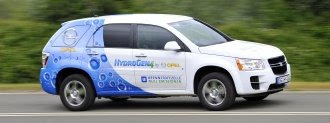 It feels all wrong, for a green car enthusiast, to be climbing into the garishly upholstered driving seat of a Chevrolet Equinox soft-roader. It’s a big, square, two-tonne blue box with reverse-Tardis packaging. The viewpoint is commanding, the steering wheel is on the wrong side, and the air-con is blasting away to tame the summer heat. Worse, the 4x4 proportions are just for show - this is a front-wheel drive car. All in all, it’s not a very promising prospect for keeping our CO2 output under control.
It feels all wrong, for a green car enthusiast, to be climbing into the garishly upholstered driving seat of a Chevrolet Equinox soft-roader. It’s a big, square, two-tonne blue box with reverse-Tardis packaging. The viewpoint is commanding, the steering wheel is on the wrong side, and the air-con is blasting away to tame the summer heat. Worse, the 4x4 proportions are just for show - this is a front-wheel drive car. All in all, it’s not a very promising prospect for keeping our CO2 output under control.
But this beast has got it where it counts, and we aren’t outputting any CO2 at all today. This is not just any Chevy - it’s a HydroGen4 fuel cell research vehicle. Somewhere behind us are three bulky carbon-fibre fuel tanks pressurised to a fearsome 700 bar, full of a surprisingly small mass of hydrogen gas. Just 4.2 kilos of the stuff is good for 200 miles, apparently. Under the bonnet is a 73kW electric motor, powered by a fuel-cell stack that splices the hydrogen from the tank with oxygen from the air to produce nothing at all but electricity and water.
Alongside us rides a minder from GM Europe, who seems surprisingly relaxed given that we are about to pilot this expensive prototype on the demanding Hill Route at Millbrook Proving Ground.
We take Loop 1 and 2 on the course, which takes in slopes steeper than 1 in 10 both uphill and down, plus some sweeping corners replicating a typical British B-road.
We weren’t sure what to expect from our first drive in a fuel-cell vehicle, and are almost apologetic to report that GM has succeeded in making the HydroGen4 highly unremarkable to drive. The only electrifying experience on offer would involve grabbing a handful of cables under the bonnet.
The car starts on a normal turn of a conventional key - silently, of course, except for a sudden rush of chilled air from the dashboard vents. We slot an ordinary auto-box selector from P into D, release the ho-hum handbrake, and we’re off.
Throttle response is instant, the urge on offer reasonable. It’s no sports car, but it’s no slug either. The regenerative brakes offer no feel whatsoever, but numbness probably comes as standard in an Equinox. The helm responds to inputs in the expected manner, with pots of power assistance and little precision.
Progress is smooth and very quiet, with the deliberately poor surface making no impact through the big tyres and soft suspension. If the gearbox changes ratios we don’t notice - they’re not often needed in a car powered by electric motor. The box offers no special ratio for steep descents, as you will find in a Prius or Civic Hybrid, which can both increase their rate of regenerative retardation to capture extra energy and to spare the brakes on a downhill stretch. As we crest a rise and are faced with a road that drops away like a tarmac-covered ski-slope, we ask our minder what the best technique is for keeping downhill speed in check. “Use the brakes,” he says, with a shrug.
Uphill is similarly straightforward. The motor, less beefy than the one that will find its way into the upcoming Opel Ampera, provides acceleration even when hauling the HydroGen4 up a 10% slope.
There’s plenty to argue about when it comes to hydrogen as a road fuel. It’s energy intensive to produce, requires more energy to pressurise, and in worst-case scenarios can account for more released CO2 per kilometre than petrol. On the other hand, if it can be produced from renewable energy, it offers the genuine prospect of zero-emissions motoring without the need for lots of lithium. It’s generating the renewable energy that is the hard part, of course. Plus there is the not inconsiderable hurdle of establishing a hydrogen refuelling infrastructure.
There is also plenty to argue about when it comes to fuel cells, particularly the staggering expense of making them at present. GM doesn’t say how much it costs to create the HydroGen4’s stack, but it’s likely to loiter in the region of $200,000.
So while we remain sceptical of hydrogen’s future as a fuel, there is not much to argue about from behind the wheel. It’s amply clear that hydrogen can be made to propel a car with no drama at all.
We drive a big off-roader from GM
25 June 2009
Read more about: fuel cells GM test drives



